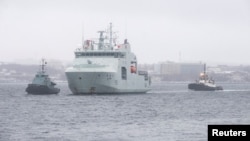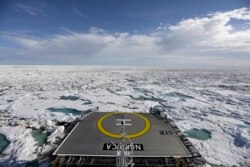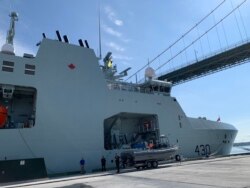Amid growing competition for control of the Arctic seaways, Canada’s navy has re-entered the region after a decades-long absence with a versatile new class of vessel that is equally at home in the frozen North or in tropical seas.
The HMCS Harry DeWolf recently became the first Royal Canadian Navy ship to sail through the Northwest Passage in 60 years, part of a rare circumnavigation of North America that later took it through the Panama Canal and into the Caribbean Sea to participate in anti-narcotics operations.
Canada’s Coast Guard has long been active in the high Arctic, reinforcing the nation’s claim to sovereignty over the fabled waterway that became a graveyard for at least one 19th century explorer. But with climate change prompting new interest in potential Arctic trade routes, the Canadian navy is expanding its role.
“Canada has long paid lip service to the importance of Canadian Arctic sovereignty, but the defense of the Arctic has long been a low priority for Canadian military expenditures,” said Charles Burton, an expert with the MacDonald-Laurier Institute in Ottawa.
“Now with increasing strategic interest in the region by China and opening up of year-round shipping lanes due to global warming, Canada is waking up to the need to ally with the United States and other like-minded nations and commit resources to uphold its claim to its northern territory.”
Canada’s claim to sovereignty over the Northwest Passage is in fact challenged by the United States, which argues that it and a similar Arctic Sea route across the top of Russia should be considered international waters.
But the dispute has not hindered cooperation between the North American neighbors. An American officer, Navy Lt. j.g. Kyle Luchau, was on board the Harry DeWolf for its historic voyage in what a Canadian military spokesperson described to VOA as a “special … but not a rare occurrence.”
Luchau’s role during the four-month voyage, spokesperson Mark Gough said, was “sharing information, sharing ideas, point of view.”
The Harry DeWolf, launched in mid-2020, is the first of six Canadian vessels in a class that bears the same name. Despite its length—103 meters, making it the largest Canadian warship to be launched in more than 50 years—it is smaller than many U.S. icebreakers.
“Canada and the U.S. appear to have taken different paths with respect to Arctic ship building,” said Adam Lajeunesse, a professor at Canada’s St. Francis Xavier University. “While the U.S. remains focused on larger, heavy icebreakers, Canada has chosen lighter ice-strengthened patrol ships.”
Lajeunesse said the Canadian ships are “far less capable in the heavy Arctic ice” but they “are cheaper and easier to build – that means there will be more of them.”
“The U.S. building program is based on a broader set of responsibilities. After all, the U.S. needs to access Antarctica as well, and a patrol ship won’t do that job. Over the longer term, however, there will be more and more activity in the North that needs to be monitored and policed,” Lajeunesse told VOA.
“Chinese fishing fleets, foreign commercial vessels, cruise ships, and other safety, security, and defense threats will proliferate … Over time, the U.S. may want to adjust its own building program to put more emphasis on quantity over icebreaking quality.”
The Harry DeWolf began its trip around North America in August, sailing northward from its home port in Halifax, Nova Scotia, to waters near Greenland, where it engaged in joint drills with U.S. icebreakers in an exercise labeled Operation Nanook.
After an east-to-west crossing through the Northwest Passage, it entered the Pacific Ocean through the Bering Strait and followed the Pacific coastline south to the Panama Canal.
Upon entering the Caribbean, the ship exhibited its versatility by participating in a totally different type of mission — working with U.S. forces to interdict drug-trafficking vessels in what the Canadians call Operation Caribbe.
Gough, the Canadian military spokesperson, said the Harry DeWolf’s role was to patrol the tropical waters with U.S. Coast Guard personnel on board. When a suspected drug smuggling vessel was stopped, the Americans would board and search it.
Without such raids, Gough said, the dangerous narcotics that are seized would “certainly end up on Canadian streets.”
The Harry DeWolf returned to Halifax in mid-December, completing its journey around the continent. Military sources have told VOA the ship will soon be heading back south for another deployment as part of Operation Caribbe, but this time without Commander Corey Gleason, who directed it through its circumnavigation.
Gleason, who told VOA he is “likely the longest serving commanding officer in the Royal Canadian Navy,” is scheduled to step down this month. He said he will take up a senior position in the navy’s sea training unit where he will become “a mentor” to future Arctic and Offshore Patrol Ship captains.






